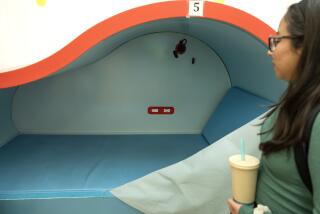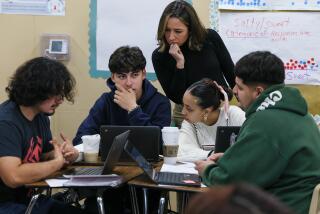Online Classes Launch CSUN Into Cyberspace
NORTHRIDGE — Buried deep within the Cal State Northridge Internet Web site is an electronic cry for help.
“Hello,” reads the e-mail message. “We’re totally lost!!!!!”
While such signs of techno-panic are still common as learning moves to cyberspace, CSUN students and professors are giving high marks to the university’s so-called virtual classes, introduced during the fall semester.
The CSUN courses, dubbed the “Cyber Seven,” span the academic spectrum from developmental mathematics to music appreciation. They represent the university’s first major effort to educate via the Internet and are certain to be the first of many classes.
Colleges and universities are preparing for a time when large numbers of students will enroll in classes delivered via computer or satellite TV. Cal State University officials have even proposed creation of a “Virtual University.”
Half of the CSU system’s 22 campuses will offer Internet courses by the end of the current school year, according to the California State University Office of Extended Education.
“If we don’t fulfill that need or address that problem, somebody else will,” said CSUN sociology professor Jerald G. Schutte, who is teaching one of the Internet courses.
Indeed, universities across the state are racing to establish themselves as leaders in “distance learning” technologies.
Although in recent years more than 130 CSUN instructors have created online sites known as home pages, they serve mostly as a place for students to swap study tips and class news, said John Hartzog, director of CSUN’s Learning Resource Center.
The Cyber Seven courses are far more technologically ambitious and, administrators hope, will appeal to students who live far from campus, work full time or for other reasons would benefit from such nontraditional classes.
With a few clicks of the mouse, students in Carlos Maldonado’s music-appreciation course can move from analyzing Lightnin’ Hopkins’ gritty “Rainy Day Blues” to identifying the acoustical characteristics of an oboe.
If you have a personal computer, said Hartzog, “the music plays . . . whether you’re in Northridge or Bakersfield or Alaska.”
While some of the classes stick close to the prescribed syllabus, others embody the controlled-chaos attitude many computer lovers say is a great joy of cyberspace.
*
Among the most eclectic and elaborate is the home page for Speech Communications 454: Communication and Technology, a class designed to examine how humans interact in a world linked by computers.
Created by instructor Ben Attias, a 10-year Internet veteran, the page offers a wide range of assistance for undergraduates and graduate researchers alike. It also directs users to articles, graphics and information on such hot-button communications topics as pornography on the Internet and corporate influence in the mass media.
Like most of the Cyber Seven instructors, Attias convened his first classes in a real classroom. As students slowly acquired knowledge and confidence on the Internet, the class began spending more and more of its time in cyberspace.
The amount of time classes spend on the computer varies. As the end of the semester nears, some of the instructors are delivering most of their lectures electronically, by posting prepared texts, in most cases. Other classes still meet primarily in a classroom and go online for lab work, to attend electronic study sessions or question-and-answer sessions with the teacher.
In some courses, students know virtually all their classmates by name and face. In others, they know each other mostly by online nicknames.
To prevent cheating--an issue that will have to be addressed before the proposed California Virtual University can begin exporting classes--most tests are taken in person.
To the surprise of some teachers, many of the students in the Cyber Seven courses were not computer literate when they enrolled. And teaching them to navigate the virtual classrooms took as much as several weeks.
Not surprisingly, glitches in the university’s hardware and software also popped up--although a new system is performing more reliably than in the recent past, students and administrators said.
The Cyber Seven students and teachers are test subjects of a sort as the school decides what role online instruction should play in its future.
The instructors are keeping journals of their experiences and meet periodically to discuss what works and what doesn’t. They plan to post their findings and recommendations on the Internet.
“These are new methods of delivery, and we can’t assume that the past methods we used for teaching and learning are the best for this new system,” said Margaret Fieweger, associate vice president for undergraduate studies at CSUN.
A pioneering study of the effectiveness of the cyber courses is taking place in Schutte’s social statistics class, which he intentionally overbooked and divided into two groups on the first day.
One group meets in a campus classroom. The second group takes the course--with the same lectures, same assignments, same instructor--by computer.
When finals are completed, Schutte will compare test scores and performances of the two groups in an attempt to lend statistical evidence to what has been a mostly anecdotal debate of the merits of online education.
*
It is important the university not be “swept away by the technology,” holding classes online simply because it can, Schutte said.
That is a sentiment shared by Dianne Davis, a graduate student in the communication and technology course, whose final paper will explore the use of high technology in education.
“I just hope they have some caution,” she said of those designing CSUN’s high-tech future. “I hope they look at what an online class can offer, but also the possible drawbacks.”
While virtual teaching is likely to be neither the low-cost, high-output educational panacea some predict, nor the end of personal, face-to-face teaching, as others contend, CSUN officials believe it may help the university reach out to an ever-expanding student population.
And so far, students in the Cyber Seven classes said, the university seems to be headed in the right direction.
One CSUN student e-mailed his highest rating to classmates: “[Expletive] this class is cool.”
More to Read
Sign up for Essential California
The most important California stories and recommendations in your inbox every morning.
You may occasionally receive promotional content from the Los Angeles Times.










